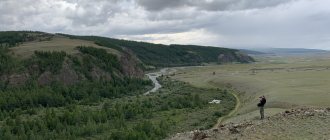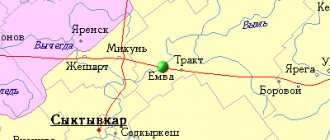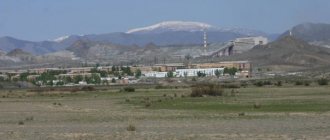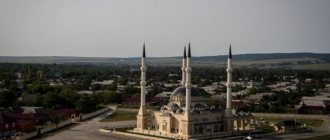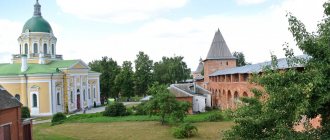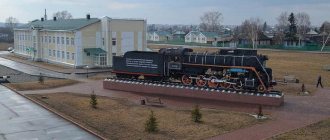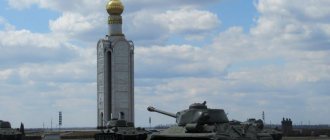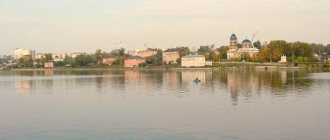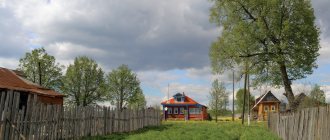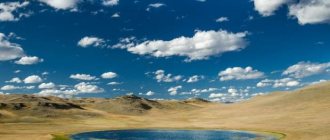Most tourists perceive the city of Kyzyl as a transit point on the way to treasured mountain peaks, national parks or picturesque lakes. But those who decide to stay here for a few days leave the capital of Tuva delighted. The central square is buried in flowers, the embankment captivates with its beauty and comfort. In addition, the city has many unique places. So what are the sights of Kyzyl?
Prayer drum
Opened in 2006 on the central square of the city, opposite the Music and Drama Theatre. A little later, a prayer house for the drum was erected in the form of a pagoda, which was decorated with elegant ornaments.
The drum itself, made of copper, contains 115 million leaves with mantras written on them. It must be rotated clockwise. One turn - one prayer. And you don’t have to be a Buddhist to ask heaven for health, good luck and prosperity.
And this unique structure was presented to the city by the monks from the Tyudmed monastery, who responded with gratitude to the local residents for their help in the construction of sand mandalas. The significance of the gift is difficult to overestimate: in Buddhism, prayer wheels are revered as sources of the greatest blessing.
Crime capital
Despite its multinational composition, Kyzyl is not a place of ethnic strife. The bulk of crimes committed in the Tuvan capital are of a “domestic nature.” Fights occur quite often, including fatal ones, which, for the most part, occur after excessive drinking of alcohol. Intoxicated Kyzyl residents grab a knife, thus trying to resolve family and everyday conflicts, quite often caused by jealousy. Thus, in 2012, the Kyzyl Department of Internal Affairs recorded 2,105 crimes:
- Severe – 768;
- Thefts – 637;
- Distribution and use of drugs and potent substances – 485;
- Those with an economic focus - 72;
- Committed by minors – 98.
As noted by the Department of Internal Affairs of the city of Kyzyl, the number of crimes in the city increased by 5.4% compared to the level of 2011. The overall detection rate was 73%.
The most “terrible” year in terms of the number of murders committed in this millennium was 2003, when 557 particularly serious crimes occurred (323 cases of intentional infliction of grievous bodily harm causing death and 234 murders). The high wave of murders lasted in the Tuvan capital for another two years (2004-2005), after which law enforcement agencies in Kyzyl noted a decrease in these “terrible indicators.” However, if we take the total number of serious crimes based on the number of residents of the republic, we can note that Tuva is ahead of the Russian average:
- in murders 5 times,
- intentional infliction of harm to health causing death – 3 times.
- for rape - 3 times.
And given the fact that 1/3 of the total population of the republic lives in Kyzyl, it is easy to guess where the center of crime is concentrated.
The last “high-profile case” discussed by all residents of Kyzyl was the murder of the best athlete of Tuva of the 20th century in khuresh wrestling - 24-year-old Chechen-ool Mongush. Who is charged? The servant of the people, former deputy of the Supreme Khural of Tuva, Roman Mongush, was found guilty. Several other high-profile cases this year involved the rape of minors (children aged 7-12 years), the beating of suspects by police officers, and the discovery and closure of 17 underground clubs with slot machines.
Kyzyl residents also remember the terrible tragedy that took place 11 years ago, when two townspeople were brought to the sacred spring with healing water - Kundustug Arzhaan and brutally killed, inflicting about 50 knife wounds on one of them, and the second was completely deprived of his head. The criminals were captured and convicted, but they will soon be released again and will probably return to their hometown. What awaits their next victim when the criminals attack someone else in their drunken stupor? The burning question: “How to stop the unmotivated murders that happen so often in Kyzyl?” - remains unanswered for now.
Buddhist Temple Tsechenling
This is one of the brightest, in the truest sense of the word, attractions of the city of Kyzyl. The name of the temple is translated as “The Abode of Boundless Compassion.” It is small but very cozy. Local residents talk about a tradition that came from nowhere: before entering the temple, you should walk around it three times clockwise, touching each corner. By the way, they are already terribly worn out, which means they don’t visit it for the sake of beauty.
The temple building amazingly combines the traditions of ancient Buddhist architecture and modern construction technologies. At first glance, everything is very simple: white walls, a wide main staircase, a pediment decorated extremely modestly, and a roof traditional for eastern countries with corners curved upward.
The first floor of the temple is occupied by the residence of representatives of the Dalai Lama. On the second floor there is a prayer hall with a luxurious altar. Between the floors there is a massive marble staircase.
Eight stupas were erected on the territory of the shrine, each of which reflects the events of the life of Buddha.
Under Tsechenling, classes are organized for everyone who wants to learn the Tibetan language, learn yoga, the secrets of meditation and the philosophy of Buddhism. In addition, here you can freely talk with the lamas and even join their classes.
Ubsunur Basin
This natural biosphere reserve is state-owned and is located in the water basin of Lake Uvs-Nur of the same name (Southern Siberia). It is considered a UNESCO heritage site. The reserve is transboundary - located on the territory of not only Russia, but also Mongolia. Founded in early 1993.
The area of the reserve is more than 323 thousand hectares. The territory is divided into 9 separate areas ranging from 800 to 122 thousand hectares.
The reserve is attractive due to its mixture of complex ecosystems. It includes deserts, steppes, alpine meadows, tundra, taiga, and glaciers. The territory contains approximately 80 species of mammals and 360 species of birds. Some animals are endangered.
Tuva State Philharmonic
One of the oldest attractions in Kyzyl (see photo below) was opened on April 1, 1969. Today it is located in the building of the Kok-ool Music and Drama Theater. Six groups work here for guests, each of which is a bearer of national musical culture. But they perform not only folk music. Their repertoire includes many classical and symphonic works. Touring famous Russian dance ensembles and musical groups perform here.
The Philharmonic also has its own “Theatre of Miniatures”, a rock laboratory, and a choreographic studio for children “Sayany”.
Ustuu-Khuree
This is the largest widely known Buddhist monastery in Tyva. It is located in the Chaylag-Alaak tract, not far from the city of Chadan. Founded more than a century ago in 1905.
The monastery was almost completely destroyed in the 30s of the 20th century, but only at the end of 1999 it began to be restored. Today it is the center of spirituality and statehood of Tuva. Here the foundation of the Tuvan alphabet was laid and the first coin of the Tuvan People's Republic was minted.
An international festival of live music and faith, named after the Ustuu-Khuree monastery, is held annually. It opens with an unusual and colorful ritual procession. There are 4 concerts in one day.
National Museum of the Republic of Tuva
The museum owes its appearance to caring local residents who resolutely began studying the history of the republic and its capital. There are several legends about this. In one of them, the creation of the museum is attributed to consul I. Chichaev, who put forward a proposal to form the Uriankhovedeniya society. According to another, the initiative belongs to the editor-in-chief of the local newspaper F. Pudalov. Historians claim that this landmark of Kyzyl (Tuva Republic) owes its appearance to chance: in 1924, pieces of ore, pipes, household items, clay shards, jewelry, etc. were found. Museum guests most often linger near shamanic drums, figurines, painted national dishes, reconstructions of the dwellings of the peoples living in this territory.
Shamanic clinic
In front of the shaman center there are two large yurts. It is impossible to miss this attraction. There are currently seven shamans working at the clinic.
The secrets of ancient methods used by shamans are passed down from generation to generation. Do you dream of learning how shamans work? The doors of the center are open to everyone. This shamanic clinic is considered one of the best in Tyva.
Address: st. Red Partisans, 18.
Nadya Rusheva Museum
This is a unique place in its own way. The museum of the young self-taught artist has more than 380 works. The townspeople revere Nadya as their countrywoman. The girl’s mother is the first ballerina of the republic; her father came to Tuva in 1945 to become a production designer for a drama theater.
Nadya started drawing in kindergarten, at the age of five. Before school, she did not receive any education, that is, she was not taught literacy, reading, or even drawing. From the first grade, the girl drew every day after school, and then more. But... her life was cut short when she turned 17 years old.
Azas Nature Reserve
The facility is state-owned and is located in Todzhinsky kozhuun. It was founded in early 1985 and occupies more than 300 thousand hectares. The territory has a picturesque topography.
The reserve is located in the Todzha Basin, which belongs to three mountain systems. The territory contains several dozen large lakes, including Many-Khol, Kadysh, Azas (Todzha).
73% of the reserve is occupied by forests. There are about a thousand species of higher vascular plants, as well as bryophytes and lichens. Some species are listed in the Red Book.
The fauna of the reserve is represented by 15 species of ichthyofauna, 51 species of mammals, 230 species of birds. Some species are listed in the Red Book.
Holy Trinity Church
Although Orthodoxy is far from the dominant denomination in Tuva, the majority of the Russian-speaking population of the republic are believers. And Christianity took root here only recently by historical standards - in the middle of the last century, thanks to the arrival of Russian gold ore seekers. But strange as it may sound, the Holy Trinity Church is the oldest shrine in the republic.
This attraction of Kyzyl is quite modest in appearance. It was originally built of wood, and only several decades later (since 1929) it was reconstructed. The temple ensemble consists of the main building, a tower with bells and outbuildings. The high cone-shaped roof with a small dome, unusual for such structures, is visible from afar. And the blue shade in which the temple is painted contrasts pleasantly against the background of city buildings.
Unique shrines are kept here: the icon of St. Nicholas, the Vladimir Icon of the Mother of God, the icon of St. Blessed Xenia of Petersburg and the icon of St. Joasaph.
A children's Sunday school is open in the Holy Trinity Church. Here they practice church singing, the Law of God and handicrafts. And in the summer, a children’s camp operates within the walls of the shrine.
Climate and ecology of Kyzyl
In terms of its climatic characteristics, the city is equal to the regions of the Far North. A significant influence on the climatic parameters of Kyzyl is exerted by its location in a basin, surrounded on all sides by hills. Severe winter with little snow with temperatures dropping to −52°C, with average January frosts of −28°C. Even in the mildest winters there are no thaws in Kyzyl. The short spring quickly turns into summer. Already in May the weather is hot here (up to + 37°C). In summer it can be +40°C. Prolonged droughts often occur. At the beginning of summer, dust storms and strong hurricanes often occur. Frosts begin in September. During this period, the difference between day and night temperatures can be 30-40°C (at night -10°C, and during the day up to + 30°C).
Yenisei
But not only large temperature changes, harsh winters, dust storms and periodic earthquakes cause headaches for Kyzyl residents, the Yenisei, which actually begins here at the confluence of the Kaa-Khem and Biy-Khem rivers, often makes residents of the coastal areas of the city worry, causing spring floods every year. And from an environmental point of view, Kyzyl is not a completely favorable place.
Kyzyl CHPP
The main sources of pollution are: Kyzyl CHPP, boiler houses, the private sector and urban transport. It is worth noting that in comparison with the period of the dashing 90s, currently the total amount of emissions of substances polluting the city’s atmosphere has decreased by almost 5 times. But soot and soot in the air of the Tuvan capital, especially in winter, is a real problem! Soot not only makes it impossible to dry clothes outside, but also creates serious problems for people suffering from asthma and bronchitis.
The maximum amount of soot was found in the private sector with stove heating; the southwestern and northern regions of Kyzyl are also heavily polluted. In addition to the ubiquitous soot, the air basin of the capital Tuva contains substances harmful to health such as:
- Heavy metals (maximum amount found at gas stations);
- Lead (in the gas station area exceeds the norm by 4 times);
- Mercury (in the gas station area exceeds the norm by 13 times);
- Cadmium (exceeds the norm both in Kyzyl itself and in the suburbs by an average of 3 to 33 times)
Also in the air basin of Kyzyl there is an increased content of such harmful substances as:
- Arsenic;
- Nickel;
- Cobalt;
- Manganese;
- Ammonium.
A relatively low level of pollution in the “lungs of the city” was recorded in the right bank and eastern parts of the suburb, in the area between Sputnik and the hippodrome. The government of Tuva and the city leadership are striving to reduce the level of soot in the air and achieve the already forgotten “snow-white” winter cover through innovative developments. And, I must say, such developments have already appeared, but, as always, there are not enough funds for their implementation. So the residents of Kyzyl have to receive their annual 130-kilogram portion of pollutants, a good half of which comes from motor vehicles.
Tuvan winter
The ecological situation is aggravated by the very location of the Tuvan capital - the foundation pit collects all the “atmospheric dirt”, not allowing it to dissipate.
The waters of the Great Yenisei and its tributaries located in the Kyzyl region are also polluted. The water here is diagnosed as “dirty” or “very polluted.” The content of harmful impurities sometimes exceeds the maximum permissible values by 11 times. So, it’s better not to swim here, despite the summer heat, it will cost more. The culprits of water pollution are: Vodokanal and the residents themselves, who want to save money on washing cars, preferring the free waters of the Yenisei to car washes.
Embankment
Four years ago, the city embankment changed beyond recognition. Now this pearl of the capital of Tuva is not just a beautiful place, a landmark of Kyzyl, but also a recreation area loved by both local residents and guests of the city.
Once upon a time, a well-known granite boulder with the inscription “Center of Asia” was installed here. Today, after the completion of the repair work, it, ennobled, returned to its rightful place.
Cathedral of the Resurrection of Christ
The main cathedral of the Tuva diocese is located in the new district of Kyzyl next to the television center. Construction work on the construction of the temple lasted more than seven years. The construction was either frozen or the work continued again.
Now the majestic temple is richly decorated inside. The cathedral looks especially beautiful in winter. The temple looks magnificent against the backdrop of snow-covered expanses.
Address: st. Moskovskaya, 7.
Mount Kezhege
The facility is located near the Mongolian border in Erzinsky kozhuun. The name of the mountain translates as “man’s braid.” It is shaped like a ring and is notable for its narrow labyrinth of stone city streets, reminiscent of old Rome. Each street is a high, narrow chasm, at the end of which there is a stone altar for offerings to the spirits.
It is believed that the mountain is the habitat of the patron spirits of shamans. According to one legend, wishes can come true in this place; according to another, the shrines of Buddhist temples in Tuva, which were destroyed during the revolution, are hidden here.
There is also a legend according to which one hunter wounded a wild goat, and while chasing it, he lost his man’s braid (a symbol of courage) and died. Because of this legend, hunting is prohibited here.
Cheder Resort
The object is located within the Kyzyl kozhuun. Tourists are attracted here by medicinal table waters, brine (a solution of highly concentrated salts) and mud. The salinity of the lake is close to 200%.
The depth of the lake is only 1.5 m, and the area is 5 square meters. km. The reservoir is attractive not only for its healing properties, but also for its reddish tint. Salt deposits are clearly visible along the shores of the lake.
Lake Dus-Khol
This lake is also called Svatikovo. It is located in Tandinsky kozhuun, 45 km from Kyzyl. The area of the lake is only 0.55 square meters. km. It has an oval shape and relatively flat banks; there is no woody vegetation.
There are several sanatoriums on the lake, and a camping base is also organized. It is popular for recreation among residents of the east of the republic. More than a thousand people come here in the summer. The lake attracts with its healing water - its properties are similar to the water of the Dead Sea. This lake is so salty that you can easily lie on its surface.
Kurgan Arzhaan-1
The mound is a royal burial place of the Scythian period of the 8th-7th centuries BC. This is the largest such structure in northern Asia. Its excavations were carried out in the 70s of the last century. A grandiose wooden structure with a log ceiling was discovered - a central log house and 70 secondary log buildings. Its construction took approximately 5 thousand massive larch logs.
The king and queen were buried in the central frame of the mound, and around them were 16 people and more than one and a half hundred horses. Gold and silver jewelry and unique items were found.
Lake Sut-Khol
This lake is also called Molochny. It is located in Sut-Kholsky kozhuun at an altitude of 1.8 km above sea level. The lake got its name because of the clouds and rocks reflected in it. Its peninsulas protrude deep into the water, creating bizarre shapes.
The lake is attractive with its clean air and the surrounding silence. In summer there are many tourists with tents, but the reservoir is considered sacred, so you cannot swim in it (and the water temperature of only 4-5 degrees will not allow this).
According to legend, there lived an old witch on the shore of the lake, who once threw a whole vat of milk into the water. The next morning the pond became snow-white, and the cows, after visiting the local pastures, gave milk as thick as cream.
The Republic of Tyva is a unique place. There is amazing nature here, many cultural objects, museums, monuments, objects of historical significance, and healing lakes. The sights of Tuva are especially interesting for residents of European cities - life and religion here have significant differences.
Lake Kara-Khol
The object is also called Black Lake (literal translation). It is located in the Bai-Taiginsky kozhuun (Western Sayan). The lake is a regional natural monument and is considered one of the most picturesque places in Tyva.
Its absolute height is about 1.5 km, and its area is 16 square meters. km. The lake is called black because of the reflection of the mountain ranges, giving the water its corresponding color. There is a small waterfall nearby.
The lake attracts not only with its views, but also with the opportunity to fish - grayling is found here in abundance.
Arzhaan Choigan
This healing source is difficult to access, but the most famous. It is located in the extreme northeast of Tuva (Eastern Sayan). Mineral waters flow out along the banks of Arzhan-Khem, a small mountain river, the right stream of Izig-Sug.
The number of indications for the use of this healing source is large. The composition of its waters is close to the Kislovodsk waters.
Bor-Bazhin (Por-Bazhin)
Translated, the phrase means “clay house.” Today these are the ruins of a fortress that was built in the 8th century. The facility is located on an island in the middle of Lake Tere-Khol.
Once upon a time it was a regular rectangle with a clear internal layout - a central structure and a system of courtyards. The purpose of the fortress has not been clarified, but this mysterious object is often mentioned in the oral folk art of Tyva. The restoration of the fortress is planned.
Aldyn-Bulak
The name of this ethnocultural complex is translated as Golden Spring. It is located in the Tandinsky district on the banks of the Yenisei. The project of the complex is a model of the Universe. The role of the Sun and planets is played by yurts, which are located according to Feng Shui.
The complex was opened in March 2011 with the aim of reflecting the national color of Tuva. It contains several ritual sites, including the Shaman's Place, the Heavenly Gate (Buddhist arch), the Sulda banners (worshipped by men), the Tojin tents, and the fire pit. There are also yurts for living, a parking lot, a sports ground, viewing gazebos, a bathhouse and a sauna. The yurts are decorated in the style of traditional Tuvan life and the wealth of Scythian times.
Uttug-Khaya
I call this mountain Leaky Rock because of the through passage connecting the western and eastern slopes. There are other names for the object - the Watchtower of Genghis Khan and the Mountain of Desires.
In the center of the through passage there is a narrow hole through which you can get to the southern slope. According to legend, a person who overcomes this obstacle will have their cherished desires fulfilled.
